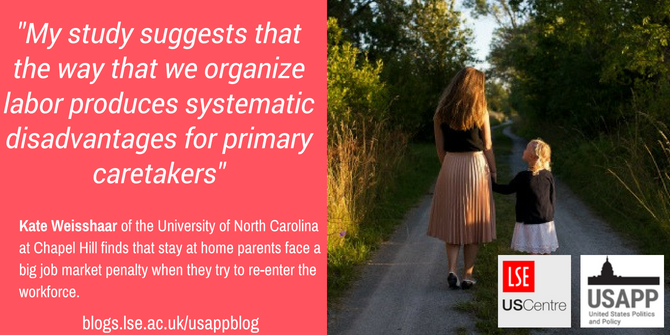 Like those who are trying to return to the workforce after being unemployed, stay at home parents also face a disadvantage when trying to find a new job. But which is a greater disadvantage for jobseekers, unemployment or having been a stay-at-home parent? In new research which examines job openings across 50 US cities, Kate Weisshaar finds that compared to job applicants that were already employed, stay-at-home mothers and fathers were significantly less likely to be called back by an employer for a job – less likely even than those who had experienced a period of unemployment.
Like those who are trying to return to the workforce after being unemployed, stay at home parents also face a disadvantage when trying to find a new job. But which is a greater disadvantage for jobseekers, unemployment or having been a stay-at-home parent? In new research which examines job openings across 50 US cities, Kate Weisshaar finds that compared to job applicants that were already employed, stay-at-home mothers and fathers were significantly less likely to be called back by an employer for a job – less likely even than those who had experienced a period of unemployment.
The decision to become a stay-at-home parent is often not easy – many parents weigh the costs of career sacrifices relative to the benefits of increased family time. But, they might want to consider another cost: how easy will it be to return to work?
Previous research has demonstrated that unemployed job applicants are disadvantaged in the hiring process, relative to applicants who had no gaps in their employment. Researchers have also studied how parents who try to balance family demands with inflexible workplaces can face penalties at work – sometimes leading them to “opt out” of work to become stay-at-home parents. My recent study builds on this research to examine what happens to stay-at-home parents who want to return to work.
I find that stay-at-home parents who had “opted out” of work and are trying to re-enter the workforce face challenges in regaining a job. Why? It’s not due to lack of motivation or disinterest in work, but rather because many employers have biases against job applicants who have temporarily stayed at home with their children, viewing them as less committed and dedicated to work. In fact, employers in my study preferred comparable applicants who were unemployed and laid off from their most recent job to stay-at-home parents who were out of work for the same amount of time.
Studying employer preferences
What I found came from an audit study in which fictitious résumés were sent to real job openings in 2015-2016, across 50 cities in the US.
For each of five professional occupations, I developed résumés to represent fictitious job applicants with three different employment histories: employed applicants with no lapses in work experience, unemployed applicants who were laid off from their most recent job, and stay-at-home parent applicants who quit their jobs to take care of their children. All applicants indicated they were parents, and the names of the applicants signaled they were either men or women.
Beyond these two factors – employment history and gender – all other information on the résumés was similar. Applicants had identical skills, number of jobs, and work experience. In particular, the only difference between the unemployed and stay-at-home parent applicants was the reason they reported not working for one and a half years.
This type of study – an audit study or field experiment – is used to test for patterns of discrimination. Because all of the résumé information is identical except for employment history and gender, different employer response rates to the different types of applicants implies that discrimination is occurring.

Image credit: Jon Flobrant (Unsplash, CC-0)
How do different types of employment lapses affect parents’ job market prospects?
After submitting the fictitious job applications to 3,374 real job listings, I recorded which applicants received requests for interviews or more information.
Unsurprisingly, I found that employed applicants had the highest callback rates: 15.3 percent of the employed mothers received a callback, as did 14.6 percent of the employed fathers. Unemployed applicants were disadvantaged relative to the employed applicants: 9.7 percent of unemployed mothers and 8.8 percent of unemployed fathers received a callback.
The stay-at-home parent applicants fared the worst of all. Only about 4.9 percent of stay-at-home mothers and 5.4 percent of stay-at-home fathers received a callback. This is about half the rate of the unemployed applicants, and one third the rate of employed applicants.
How do findings vary across cities in the study?
Because I conducted the study across 50 cities in the US, I was able to look at variation in callback rates across cities, focusing on whether there were different results in cities with more or less competition for jobs.
The idea behind this part of the study is that when cities have higher competition for jobs – more job seekers looking for these types of professional jobs – then employers are more easily able to act on their preferences for applicants. For example, if an employer has 100 applicants for a job opening, they can be pickier about excluding applicants than if they have just 10 people to choose from.
I found that in cities with high levels of job competition, employed fathers were preferred over all other applicant types. Employed mothers, while not disadvantaged in the aggregate callback rates, did face a penalty in competitive cities. For example, in cities with relatively high job-seeker rates of 7 percent, my analyses predict that employed fathers had a 15.7 percent chance of receiving a callback, compared to employed mothers’ predicted callback rate of 7.9 percent.
Stay-at-home mothers’ callback rates remained consistently low no matter the city context, and stay-at-home fathers did somewhat worse in more competitive markets than they did in less competitive cities. I did not find a clear relationship between city-level measures and unemployed applicants’ callback rates. These findings suggest that employment lapses – family-related lapses in particular – send strong negative signals to employers in all markets, whereas motherhood is viewed negatively among employed applicants only when employers have lots of applicants to choose from.
Why are stay-at-home parents penalized in the hiring process?
In addition to the audit study, I fielded a survey experiment to examine attitudes about these types of job applicants. Survey respondents read two fictitious résumés – one continuously employed applicant and either an unemployed or stay-at-home parent applicant. Similar to the audit study, the only difference in the résumés between the unemployed and stay-at-home parent applicants is the reason for the employment gap. Respondents evaluated each applicant based on how capable, committed, reliable, and deserving of a job they found the applicants to be.
I found that survey respondents viewed both the unemployed and stay-at-home parent applicants as less capable than employed applicants. This could correspond to perceptions that applicants’ skills became rusty while they were not working.
This is where the similarities ended when comparing unemployed and stay-at-home parent applicants. Respondents viewed stay-at-home parents as less reliable, less deserving of a job, and much less committed to work, compared to unemployed applicants. On some measures, stay-at-home fathers faced an even greater penalty than stay-at-home mothers.
What does this tell us about work, family, and gender?
These findings suggest that stay-at-home parents are viewed by employers as violating “ideal worker norms.” Ideal worker norms are expectations that employees dedicate themselves completely to work – working long hours, always being available for work-related activities, and prioritizing work over other areas of life. Because these norms are ubiquitous in professional workplaces, employers may believe that stay-at-home parents – by previously prioritizing family over work – are not as dedicated or committed to work as they would like employees to be.
My study suggests that the way that we organize labor produces systematic disadvantages for primary caretakers. Mothers are more likely than fathers to experience employment interruptions for childcare; in some cases, they are “pushed out” of work when workplaces are inflexible and demanding. My research shows that, after being pushed out, they are kept out of work and experience reduced job opportunities when attempting to regain employment.
Stay-at-home fathers also face penalties, and in some contexts these penalties are larger than those for stay-at-home mothers. In my work, I argue that this is because fathers experience higher expectations to uphold ideal worker norms than mothers do, and are thus punished to a greater extent when violating these norms. This idea is reinforced in the audit study cross-city results: in competitive job markets where employers have their choice of applicants, employed fathers benefit over other applicants.
My research shows that ideal worker norms can produce challenges for parents who want to work. Not only do these norms contribute to parents leaving work in the first place, but the same norms are activated when employers evaluate stay-at-home parent job applicants. In other words, inflexible work environments with long hours, demanding cultures, and expectations to always be available produce a reinforcing system that holds back parents’ career prospects. Until we change these workplace norms, it is likely that parents will continue to experience challenges in their careers.
- This article is based on the paper, “From Opt Out to Blocked Out: The Challenges for Labor Market Re-entry after Family-Related Employment Lapses” in American Sociological Review.
- A version of this article first appeared at the Work in Progress blog.
Please read our comments policy before commenting
Note: This article gives the views of the author, and not the position of USAPP– American Politics and Policy, nor of the London School of Economics.
Shortened URL for this post: http://bit.ly/2Kr2T8J
About the author
 Kate Weisshaar – University of North Carolina at Chapel Hill
Kate Weisshaar – University of North Carolina at Chapel Hill
Kate Weisshaar is an Assistant Professor in the Department of Sociology at the University of North Carolina at Chapel Hill. Her research examines gender inequality in the labor market and in workplaces, and the work-family intersection.






